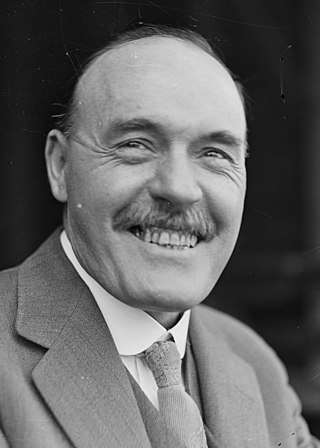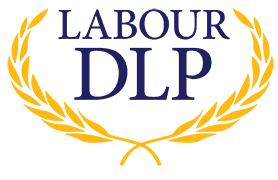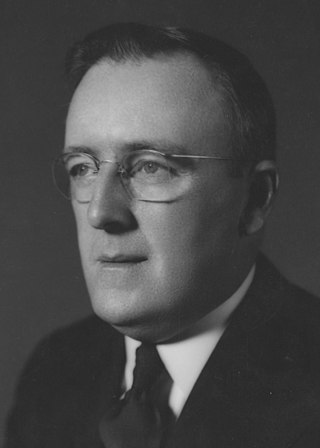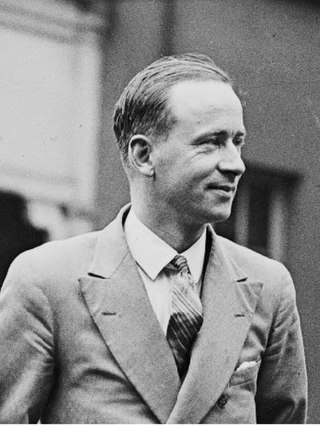
The United Australia Party (UAP) was an Australian political party that was founded in 1931 and dissolved in 1945. The party won four federal elections in that time, usually governing in coalition with the Country Party. It provided two prime ministers: Joseph Lyons (1932–1939) and Robert Menzies (1939–1941).

John Thomas Lang, usually referred to as J. T. Lang during his career and familiarly known as "Jack" and nicknamed "The Big Fella", was an Australian politician, mainly for the New South Wales Branch of the Labor Party. He twice served as the 23rd Premier of New South Wales from 1925 to 1927 and again from 1930 to 1932. He was dismissed by the Governor of New South Wales, Sir Philip Game, at the climax of the 1932 constitutional crisis and resoundingly lost the resulting election and subsequent elections as Leader of the Opposition. He later formed Lang Labor that contested federal and state elections and was briefly a member of the Australian House of Representatives.

The Democratic Labour Party (DLP), formerly the Democratic Labor Party, is an Australian political party. It broke off from the Australian Labor Party (ALP) as a result of the 1955 ALP split, originally under the name Australian Labor Party (Anti-Communist), and was renamed the Democratic Labor Party in 1957. In 1962, the Queensland Labor Party, a breakaway party of the Queensland branch of the Australian Labor Party, became the Queensland branch of the DLP.

The Communist Party of Australia (CPA), known as the Australian Communist Party (ACP) from 1944 to 1951, was an Australian political party founded in 1920. The party existed until roughly 1991, with its membership and influence having been in a steady decline since its peak in 1945. Like most communist parties in the west, the party was heavily involved in the labour movement and the trade unions. Its membership, popularity and influence grew significantly during most of the interwar period before reaching its climax in 1945, where the party achieved a membership of slightly above 22,000 members. Although the party did not achieve a federal MP, Fred Paterson was elected to the Parliament of Queensland at the 1944 state election. He won re-election in 1947 before the seat was abolished. The party also held office in over a dozen local government areas across New South Wales and Queensland.

Edward John Ward was an Australian politician who represented the Australian Labor Party (ALP) in federal parliament for over 30 years. He was the member for East Sydney for all but six-and-a-half weeks from 1931 until his death in 1963. He served as a minister in the Curtin and Chifley governments from 1941 to 1949, and was also known for his role in the ALP split of 1931.

John Smith "Jock" Garden was an Australian clergyman, trade unionist and politician. He was one of the founders of the Communist Party of Australia.

Lang Labor was a faction of the Australian Labor Party (ALP) consisting of the supporters of Jack Lang, who served two terms as Premier of New South Wales and was the party's state leader from 1923 to 1939. It controlled the New South Wales branch of the ALP throughout most of the 1920s and 1930s. The faction broke away to form separate parliamentary parties on several occasions and stood competing candidates against the ALP in state and federal elections.

James McGirr, JP was the Labor Premier of New South Wales from 6 February 1947 to 3 April 1952.

John Albert Beasley was an Australian politician who was a member of the House of Representatives from 1928 to 1946. He served in the Australian War Cabinet from 1941 to 1946, and was a government minister in the Curtin and Chifley governments. Beasley was a member of the Australian Labor Party, although on two occasions he left the party to join the breakaway Lang Labor groups, leading the faction in federal parliament. He concluded his career as High Commissioner to the United Kingdom from 1946 until his death in 1949.
The Australian Labor Party (Non-Communist), which operated from 1940 to 1941, was a breakaway from the Australian Labor Party (ALP), and was associated with the Lang Labor faction and former New South Wales premier Jack Lang.
The New South Wales Labor Party, officially known as the Australian Labor Party (New South Wales Branch) and commonly referred to simply as NSW Labor, is the New South Wales branch of the Australian Labor Party (ALP). The branch is the current ruling party in the state of New South Wales and is led by Chris Minns, who has served concurrently as premier of New South Wales since 2023.

Major Clarence Edward Martin was an Australian politician and a member of the New South Wales Legislative Assembly from 1930 until 1932 and from 1939 until his death in 1953. He was variously a member of the Australian Labor Party (NSW), the Industrial Labor Party and the Labor Party (ALP). He was the Attorney General of New South Wales from 1941 until 1953 and also held the position of Minister for Transport for six months prior to his death.
Arthur Tonge was an Australian politician and a member of the New South Wales Legislative Assembly between 1926 and 1932 and from 1935 to 1962. He was variously a member of the Labor Party (ALP), the Australian Labor Party (NSW) and the Australian Labor Party (Non-Communist)
Francis Hill was an Australian politician and a member of the New South Wales Legislative Assembly between 1941 and his death. He was a member of the Labor Party.
The Australian Labor Party split of 1955 was a split within the Australian Labor Party along ethnocultural lines and about the position towards communism. Key players in the split were the federal opposition leader H. V. "Doc" Evatt and B. A. Santamaria, the dominant force behind the "Catholic Social Studies Movement" or "the Movement".
Socialism in Australia dates back at least as far as the late-19th century. Notions of socialism in Australia have taken many different forms including utopian nationalism in the style of Edward Bellamy, the democratic socialist reformist electoral project of the early Australian Labor Party (ALP), and the revolutionary Marxism of parties such as the Communist Party of Australia.
The history of the Australian Labor Party has its origins in the Labour parties founded in the 1890s in the Australian colonies prior to federation. Labor tradition ascribes the founding of Queensland Labour to a meeting of striking pastoral workers under a ghost gum tree in Barcaldine, Queensland in 1891. The Balmain, New South Wales branch of the party claims to be the oldest in Australia. Labour as a parliamentary party dates from 1891 in New South Wales and South Australia, 1893 in Queensland, and later in the other colonies.
The Sydney University Labor Club is the oldest political society in Australia. It is one of the most influential Australian university political societies. Many of the club's alumni have gone on to prominent political careers. The club is associated with the left of the Australian Labor Party.
Carl Adrian Akhurst was an Australian accountant, secretary and politician who served as a Member of the Legislative Council of New South Wales from 1925 to 1934. Initially appointed by the Governor of New South Wales as one of 25 Labor Party appointees, Akhurst was expelled from the party after failing to vote for the Council's abolition in 1926. Readmitted to the Federal Labor Party in 1931, Akhurst unsuccessfully sought re-election as the ALP candidate to the council in 1940.
The Australian Labor Party National Conference, sometimes referred to as the National Party Conference or the Federal Conference, is the highest representative and decision-making body of the Australian Labor Party, incorporating all of the party’s state and territory branches. The National Conference takes place triennially and is hosted in Australian cities on a rotating basis. The 49th and most recent National Party Conference was held on the 17th to the 19th of August 2023 at the Brisbane Convention and Exhibition Centre and was attended by over 2,000 delegates.









